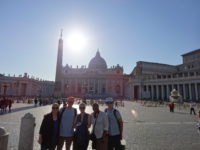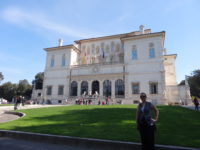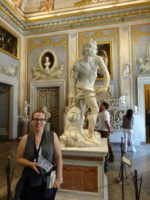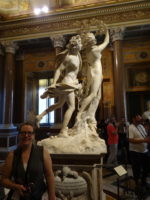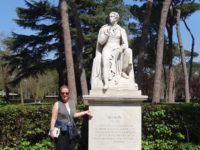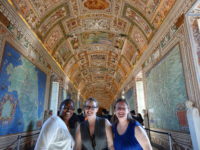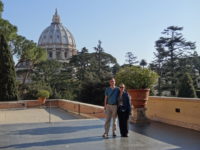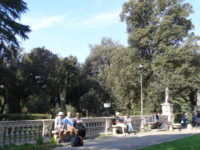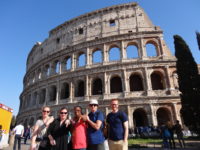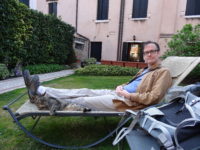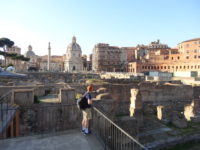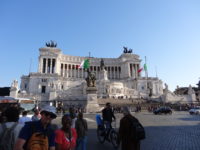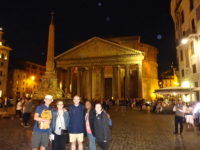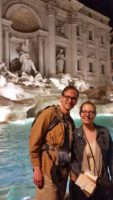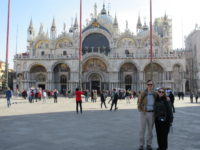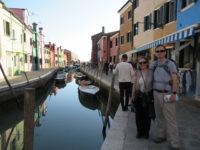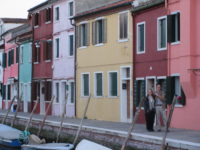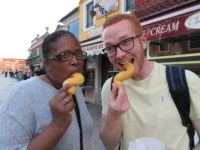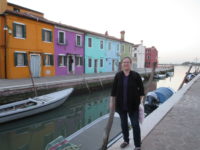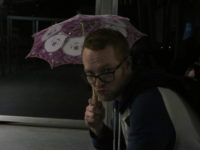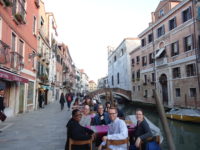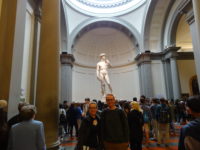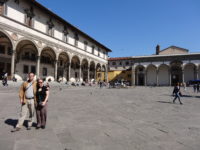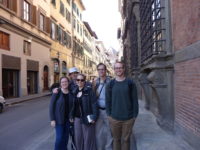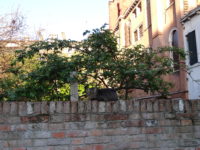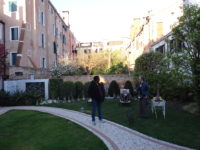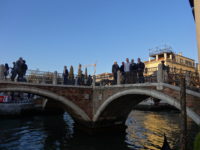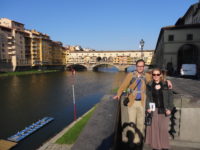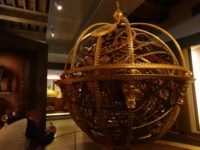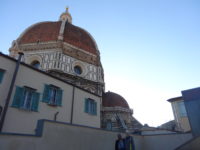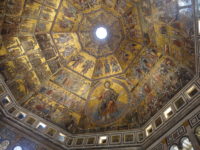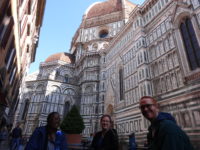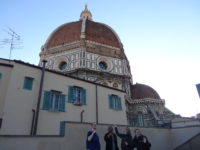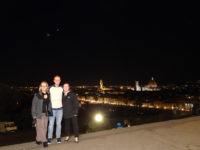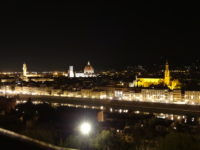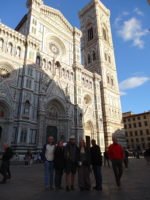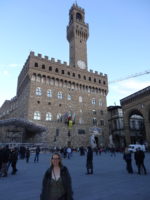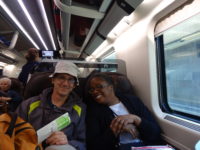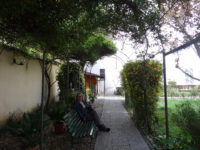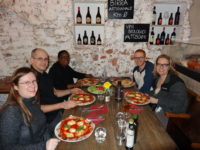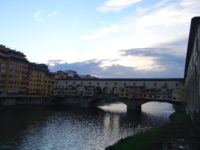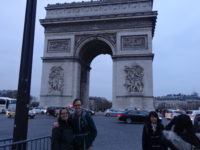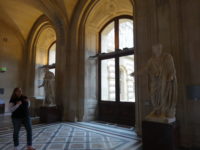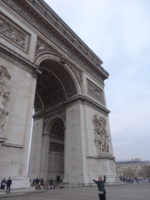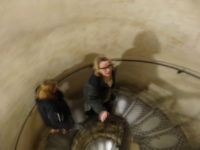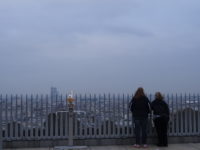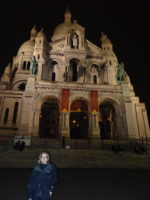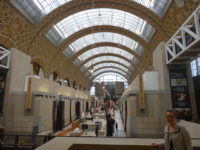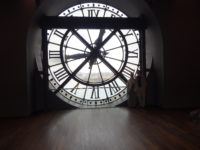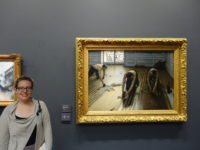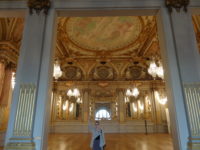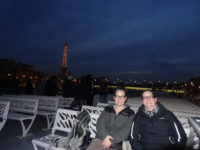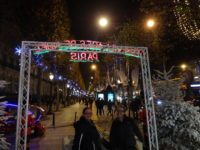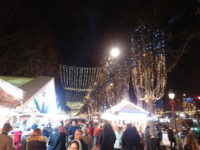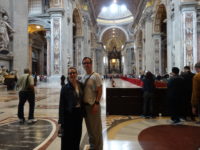 Meredith, due to the nature of her job with its accompanying huge load of grading, leads a fairly sedentary life. I’m not sure if that allows her to save up tons of energy for bursts of activity or what, but she has an uncanny ability to tour like a madwoman, walking miles and miles and still keep on going. She out-toured everyone else a bit, so at least for Saturday morning, Meredith and I were on our own while the others slept in a bit. We had agreed to meet at the Pantheon around 11:00, but Meredith and I were off at 8:00, heading over to the Colosseum metro stop to walk over to Le Domus Romane. We happened to run (ha!) into the setup area for the start/finish of the Rome Marathon, which was happening Sunday. There were a lot of runners jogging around the area.
Meredith, due to the nature of her job with its accompanying huge load of grading, leads a fairly sedentary life. I’m not sure if that allows her to save up tons of energy for bursts of activity or what, but she has an uncanny ability to tour like a madwoman, walking miles and miles and still keep on going. She out-toured everyone else a bit, so at least for Saturday morning, Meredith and I were on our own while the others slept in a bit. We had agreed to meet at the Pantheon around 11:00, but Meredith and I were off at 8:00, heading over to the Colosseum metro stop to walk over to Le Domus Romane. We happened to run (ha!) into the setup area for the start/finish of the Rome Marathon, which was happening Sunday. There were a lot of runners jogging around the area.
Le Domus Romane is a well-done exhibition of a fairly recent archaeological find that was found under an office building very near Trajan’s Column. You can now tour the site, and we had 9:30 am reservations for a tour in English. That gave us enough time to grab breakfast at a nearby cafe, with views of the Victor Emmanuel Monument, with a waitstaff that was robustly Italian – they were loud and expressive in what seemed to be the normal operations of their jobs. That was fun.
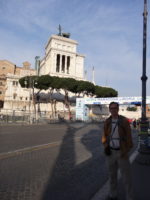 The Domus exhibit is really well done. The original excavated site is encased under glass that you walk on, which can be unnerving when you are walking on glass stairs that do not match the real stairs underneath them. Our group of fifteen or so filed into a dark room behind an Italian guide, and the recorded system started up.
The Domus exhibit is really well done. The original excavated site is encased under glass that you walk on, which can be unnerving when you are walking on glass stairs that do not match the real stairs underneath them. Our group of fifteen or so filed into a dark room behind an Italian guide, and the recorded system started up.
Through an effective use of lights and computer projectors, the narration brought to life the third century villa of some very wealthy Roman, perhaps a senator. The narration would tell us about something while the specific thing being spoken about was lighted, making it easy to identify. They used projectors to fill in gaps in mosaics, and reconstructed what walls may have looked like by projecting on to the existing sixteenth-century walls.
The rooms that have been found include a small gymnasium with a small pool, a bathing room with hot and cold pools, a sauna-like room that was heated from below by wood fires fed by Roman slaves, a kitchen, and the largest existing domestic staircase yet found, so the house was at least two stories. There is part of an earlier first-century Roman road outside the house (our word “street” come from “strata,” since Roman roads were built in layers), and a floor mosaic of the house next door was found. It was all told in a clear way, and the theory of how the house became rubble to be built upon was either a fire, or a fire caused by an earthquake, since there is evidence of burning starting in the kitchen, and some of the flooring has been cracked in places, which is consistent with earthquake damage.
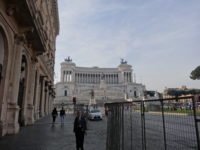 The house was originally heavily decorated with different and expensive colored marble, and some evidence of painting exists. The house was very large, probably with a courtyard or garden as well. I would have been happy with the tour had it ended there, but we were shown some artifacts from the house as well. Then, we walked along the World War 2 bunker tunnel that had been placed under the building above, until we got to a small theater, where we saw a twenty-minute video on Trajan’s Column, which has a continuous scrolling story all the way up the column. You can’t see the story up close outside, and even if you could, it would be difficult to tell what was going on. The video solved both those issues by zooming in on parts of the story and then explaining what was going on, which was mostly Trajan’s conquest of the area around present-day Romania. It was very informative, and done in an interesting way.
The house was originally heavily decorated with different and expensive colored marble, and some evidence of painting exists. The house was very large, probably with a courtyard or garden as well. I would have been happy with the tour had it ended there, but we were shown some artifacts from the house as well. Then, we walked along the World War 2 bunker tunnel that had been placed under the building above, until we got to a small theater, where we saw a twenty-minute video on Trajan’s Column, which has a continuous scrolling story all the way up the column. You can’t see the story up close outside, and even if you could, it would be difficult to tell what was going on. The video solved both those issues by zooming in on parts of the story and then explaining what was going on, which was mostly Trajan’s conquest of the area around present-day Romania. It was very informative, and done in an interesting way.
The only down side to the tour was that we got out at 11:00, which was the same time we were supposed to be meeting the others over at the Pantheon. We walked there as quickly as we could, and got to the square in front of the Pantheon about 11:30. We found Tim and Jacob waiting by the main fountain, while Regina and Meredith N. were in shops around the square. Jacob had a box of cannoli waiting for me. Our friend LT loves cannoli, so we had planned on eating some in front of something important and then sending the photos back to him. Dessert in front of the Pantheon seemed to qualify, and they were really good cannoli, too.
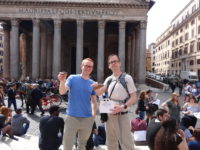 Meredith N. and Regina came back from shopping, so we all went into the Pantheon to take a look at the inside. It is large, and the dome there is as wide as the building is tall, and no dome until Florence’s Duomo fifteen hundred years later was ever made so large. There are two royal tombs in the church, for Victor Emanuel and another king of Italy, and they are guarded by an honor guard. The Pantheon was converted from a temple for all gods into a Christian church in the fourth century, and so it survived in good repair when other buildings were being looted for marble. We wandered around the interior for about thirty minutes before heading out toward the Vatican.
Meredith N. and Regina came back from shopping, so we all went into the Pantheon to take a look at the inside. It is large, and the dome there is as wide as the building is tall, and no dome until Florence’s Duomo fifteen hundred years later was ever made so large. There are two royal tombs in the church, for Victor Emanuel and another king of Italy, and they are guarded by an honor guard. The Pantheon was converted from a temple for all gods into a Christian church in the fourth century, and so it survived in good repair when other buildings were being looted for marble. We wandered around the interior for about thirty minutes before heading out toward the Vatican.
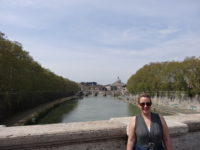 We walked to the Vatican because it seemed easier to walk than to figure out the Rome bus system; plus, we got to walk across a bridge over the Tiber with amazing views. We ate at a restaurant right outside the Vatican, which was probably a mistake. The food was fine, but we probably got ripped off. The man who sat us told us there would be a discount for six people, but our service charge (a charge for sitting down) still came to 16 euro. After the meal, he told us he could not take a credit card, so we paid cash, but then when we walked out, there was a big “Visa/MasterCard” sticker on the front door. Welcome to Rome.
We walked to the Vatican because it seemed easier to walk than to figure out the Rome bus system; plus, we got to walk across a bridge over the Tiber with amazing views. We ate at a restaurant right outside the Vatican, which was probably a mistake. The food was fine, but we probably got ripped off. The man who sat us told us there would be a discount for six people, but our service charge (a charge for sitting down) still came to 16 euro. After the meal, he told us he could not take a credit card, so we paid cash, but then when we walked out, there was a big “Visa/MasterCard” sticker on the front door. Welcome to Rome.
We had to wait in the security line of St. Peter’s for about forty-five minutes to get our bags scanned and to walk through metal detectors. We were hit up multiple times by tour guides promising to get us past the line, usually polite, but one or two were a bit rude when we told them no. I will not miss being hit up for money, that is for sure, but that is the added price of admission for anywhere that attracts tourists in Italy.
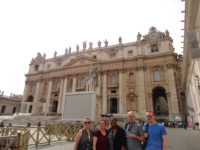 I had forgotten how huge St. Peter’s is. It is the longest church in the world, but it is also mind-numbingly high. Even the side chapels, if you put a church from one of them across to another, would make for an enormously large church anywhere. The decorations are elaborate, but not cramped-feeling like in Westminster or as thorough as at St. Mark’s in Venice. It has a very open feel to it.
I had forgotten how huge St. Peter’s is. It is the longest church in the world, but it is also mind-numbingly high. Even the side chapels, if you put a church from one of them across to another, would make for an enormously large church anywhere. The decorations are elaborate, but not cramped-feeling like in Westminster or as thorough as at St. Mark’s in Venice. It has a very open feel to it.
The church is dominated by the canopy over the altar, which was designed by the sculptor Bernini. It is made of four twisted bronze pillars, and is very, very tall. The altar is built above the tomb of St. Peter, which you can see (from a distance) in the crypt tour, which we did. We saw the tombs of several popes, including one who only reigned for twenty-two days and one who only reigned for only thirty days. I don’t know this for sure, but back when being pope also meant being the ruler of a large country, I suspect there was foul play more than once.
Meredith and I also did the treasury tour, which let us see some of the valuable and odd things the Vatican owns. We really liked several modern sculptures by the same artist, and we were impressed with a metal tomb of a pope that was never used, but showed the ten academic divisions as women around the tomb, including theology as a topless woman. Bare truth? Not sure.
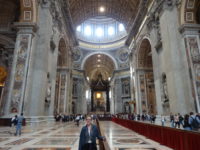 We met everyone else back at our meeting place near the bag check around 5:00, except Regina, who wanted to stay for the Latin mass at the high altar. So we waited at one end of the portico arms of St. Peter’s and watched the world go by for about forty minutes in the late evening sunshine as the sun started to go down behind the church. It was very peaceful. Jacob was able to run over to a nearby tourist tax-refund store, so he was able to get most of his money back from taxes on things he had bought. That was a good use of time.
We met everyone else back at our meeting place near the bag check around 5:00, except Regina, who wanted to stay for the Latin mass at the high altar. So we waited at one end of the portico arms of St. Peter’s and watched the world go by for about forty minutes in the late evening sunshine as the sun started to go down behind the church. It was very peaceful. Jacob was able to run over to a nearby tourist tax-refund store, so he was able to get most of his money back from taxes on things he had bought. That was a good use of time.
After Regina rejoined us, we walked back to behind the Pantheon to go to a restaurant which turned out to be closed. On a Saturday evening. In Italy. That possibility had never occurred to me. So we hiked over to the Pantheon to go to another restaurant, which turned out to be under renovations. So I gave up, and as a group we found an excellent place nearby. All is well that ends in my being fed.
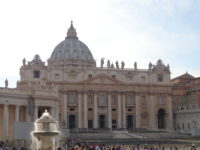 After strolling around to get dessert (some pastries, some gelato), we walked back down to the Colosseum stop of the metro, so everyone got to see the Colosseum lit up at night, which is just about a perfect a way to end our time on this trip to Florence and Venice and Rome.
After strolling around to get dessert (some pastries, some gelato), we walked back down to the Colosseum stop of the metro, so everyone got to see the Colosseum lit up at night, which is just about a perfect a way to end our time on this trip to Florence and Venice and Rome.
